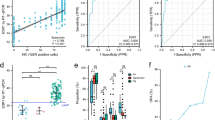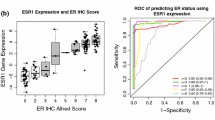Abstract
The expression of pS2 (TFF1) has been previously shown to identify patients with improved response to anti–hormonal therapy and more favorable outcome. In the current study, 100 human breast carcinoma samples obtained from the Manitoba Breast Tumor Bank were analyzed for pS2 mRNA using a quantitative, competitive reverse transcriptase–polymerase chain reaction (qcRT–PCR) assay. A pS2/ß–actin cut–off criterion of 0.010 was established to classify tumors as either pS2 positive or pS2 negative. pS2 mRNA levels were positively associated with both ER and PR, with the majority of ER+ (59) and PR+ (60) tumors also being positive for pS2. In addition, a significant linear correlation was observed between the amount of pS2 mRNA and ER (p<0.0001) and PR (p<0.0001) protein. pS2 mRNA levels also exhibited an inverse association with tumor size and histological grade, consistent with the observation that pS2 is primarily expressed in small (T < 2.0 cm), but well differentiated tumors (Grades I and II). No associations were observed with tumor cell type, patient age, or lymph node status. The strong correlation displayed between pS2 and a number of currently used breast cancer prognostic markers supports the clinical use of pS2 to further assess tumor status and patient outcome.
Similar content being viewed by others
References
McGuire WL: Current status of estrogen receptors in human breast cancer. Cancer 36: 638–644, 1975
Encarnacion CA, Ciocca DR, McGuire WL, Clark GM, Fuqua SA, Osborne CK: Measurement of steroid hormone receptors in breast cancer patients on tamoxifen. Breast Cancer Res Treat 26: 237–246, 1993
Benner SE, Clark GM, McGuire WL: Steroid receptors, cellular kinetics, and lymph node status as prognostic factors in breast cancer. Am J Med Sci 296: 59–66, 1988
Clark GM, McGuire WL: Progesterone receptors and human breast cancer. Breast Cancer Res Treat 3: 157–163, 1983
Foekens JA, Rio MC, Seguin P, van Putten WL, Fauque J, Nap M, Klijn JG, Chambon P: Prediction of relapse and survival in breast cancer patients by pS2 protein status. Cancer Res 50: 3832–3837, 1990
Foekens JA, van Putten WL, Portengen H, Rodenburg CJ, Reubi JC, Berns PM, Henzen-Logmans SC, van der Burg ME, Alexieva-Figusch J, Klijn JG: Prognostic value of pS2 protein and receptors for epidermal growth factor (EGF-R), insulinlike growth factor-1 (IGF-1-R) and somatostatin (SS-R) in patients with breast and ovarian cancer. J Steroid Biochem Mol Biol 37: 815–821, 1990
McGuire WL: Hormone receptors: their role in predicting prognosis and response to endocrine therapy. Semin Oncol 5: 428–433, 1978
Osborne CK, Yochmowitz MG, Knight WAd, McGuire WL: The value of estrogen and progesterone receptors in the treatment of breast cancer. Cancer 46: 2884–2888, 1980
McGuire WL, Clark GM: Prognostic factors and treatment decisions in axillary-node-negative breast cancer. N Engl J Med 326: 1756–1761, 1992
Klijn JG, Berns EM, Foekens JA: Prognostic factors and response to therapy in breast cancer. Cancer Surv 18: 165–198, 1993
Cardiff RD: Cathepsin D and breast cancer: useful? Human Pathol 25: 847–848, 1994
Pichon MF, Milgrom E: Clinical significance of the estrogen regulated pS2 protein in mammary tumors. Crit Rev Oncol Hematol 15: 13–21, 1993
Rio MC, Chambon P: The pS2 gene, mRNA, and protein: a potential marker for human breast cancer. Cancer Cells 2: 269–274, 1990
Predine J, Spyratos F, Prud'homme JF, Andrieu C, Hacene K, Brunet M, Pallud C, Milgrom E: Enzyme-linked immunosorbent assay of pS2 in breast cancers, benign tumors, and normal breast tissues. Correlation with prognosis and adjuvant hormone therapy. Cancer 69: 2116–2123, 1992
Masiakowski P, Breathnach R, Bloch J, Gannon F, Krust A, Chambon P: Cloning of cDNA sequences of hormoneregulated genes from theMCF-7 human breast cancer cell line. Nucleic Acids Res 10: 7895–7903, 1982
May FE, Westley BR: Cloning of estrogen-regulated messenger RNA sequences from human breast cancer cells. Cancer Res 46: 6034–6040, 1986
Rio MC, Bellocq JP, Gairard B, Rasmussen UB, Krust A, Koehl C, Calderoli H, Schiff V, Renaud R, Chambon P: Specific expression of the pS2 gene in subclasses of breast cancers in comparison with expression of the estrogen and progesterone receptors and the oncogene ERBB2. Proc Natl Acad Sci USA 84: 9243–9247, 1987
Rio MC, Bellocq JP, Daniel JY, Tomasetto C, Lathe R, Chenard MP, Batzenschlager A, Chambon P: Breast cancerassociated pS2 protein: synthesis and secretion by normal stomach mucosa. Science 241: 705–708, 1988
Valeron PF, Chirino R, Vega V, Falcon O, Rivero JF, Torres S, Leon L, Fernandez L, Pestano J, Diaz-Chico B, Diaz Chico JC: Quantitative analysis of p185(HER-2/neu) protein in breast cancer and its association with other prognostic factors. Int J Cancer 74: 175–179, 1997
Cappelletti V, Coradini D, Scanziani E, Benini E, Silvestrini R, Di Fronzo G: Prognostic relevance of pS2 status in association with steroid receptor status and proliferative activity in nodenegative breast cancer. Eur J Cancer 28A: 1315–1318, 1992
Luqmani YA, Campbell T, Soomro S, Shousha S, Rio MC, Coombes RC: Immunohistochemical localisation of pS2 protein in ductal carcinoma in situ and benign lesions of the breast. Br J Cancer 67: 749–753, 1993
Pallud C, Le Doussal V, Pichon MF, Prud'homme JF, Hacene K, Milgrom E: Immunohistochemistry of pS2 in normal human breast and in various histological forms of breast tumours. Histopathology 23: 249–256, 1993
Schwartz LH, Koerner FC, Edgerton SM, Sawicka JM, Rio MC, Bellocq JP, Chambon P, Thor AD: pS2 expression and response to hormonal therapy in patients with advanced breast cancer. Cancer Res 51: 624–628, 1991
Thor AD, Koerner FC, Edgerton SM, Wood WC, Stracher MA, Schwartz LH: pS2 expression in primary breast carcinomas: relationship to clinical and histological features and survival. Breast Cancer Res Treat 21: 111–119, 1992
Henry JA, Bennett MK, Piggott NH, Levett DL, May FE, Westley BR: Expression of the pNR-2/pS2 protein in diverse human epithelial tumours. Br J Cancer 64: 677–682, 1991
Ioakim-Liossi A, Karakitsos P, Aroni K, Markopoulos C, Delivelioti K, Gogas J, Kyrkou K: DNA ploidy and pS2 protein expression in breast cancer. Cytopathology 8: 171–176, 1997
Ioakim-Liossi A, Karakitsos P, Markopoulos C, Aroni K, Delivelioti K, Gogas J, Kyrkou K: Expression of pS2 protein and estrogen and progesterone receptor status in breast cancer. Acta Cytol 41: 713–716, 1997
Piggott NH, Henry JA, May FE, Westley BR: Antipeptide antibodies against the pNR-2 oestrogen-regulated protein of human breast cancer cells and detection of pNR-2 expression in normal tissues by immunohistochemistry. J Pathol 163: 95–104, 1991
Poulsom R, Hanby AM, Lalani EN, Hauser F, Hoffmann W, Stamp GW: Intestinal trefoil factor (TFF 3) and pS2 (TFF1), but not spasmolytic polypeptide (TFF 2) mRNAs are co-expressed in normal, hyperplastic, and neoplastic human breast epithelium. J Pathol 183: 30–38, 1997
Soubeyran I, Wafflart J, Bonichon F, de Mascarel I, Trojani M, Durand M, Avril A, Coindre JM: Immunohistochemical determination of pS2 in invasive breast carcinomas: a study on 942 cases. Breast Cancer Res Treat 34: 119–128, 1995
Hurlimann J, Gebhard S, Gomez F: Oestrogen receptor, progesterone receptor, pS2, ERD5, HSP27 and cathepsin D in invasive ductal breast carcinomas. Histopathology 23: 239–248, 1993
Soubeyran I, Quenel N, Mauriac L, Durand M, Bonichon F, Coindre JM: Variation of hormonal receptor, pS2, c-erbB-2 and GST-pi contents in breast carcinomas under tamoxifen - a study of 74 cases. Br J Cancer 73: 735–743, 1996
Inaji H, Koyama H, Motomura K, Noguchi S, Tsuji N, Wada A: Immunohistochemical survey of pS2 expression in intraductal lesions associated with invasive ductal carcinoma of the breast. Int J Cancer 55: 883–886, 1993
Robbins PD, Hahnel E, Sterrett GF, Harvey J, Carrello S, Hahnel R: Expression of the pS2 gene in breast cancer - a comparison of pS2 protein radioimmunoassay and immunohistochemistry. Pathology 25: 255–260, 1993
Takahashi S, Narimatsu E, Asanuma H, Okazaki M, Okazaki A, Hirata K, Mori M, Chiba T, Sato N, Kikuchi K: Immunohistochemical detection of estrogen receptor in invasive human breast cancer: correlation with heat shock proteins, pS2 and oncogene products. Oncology 52: 371–375, 1995
Horiguchi J, Iino Y, Takei H: Expression of pS2 estrogeninducible protein in primary breast cancer. Oncology 53: 12–15, 1996
Goussard J, Lechevrel C, Roussel G, Cren H, Bera O, Sala M: Immunoradiometric assay of pS2 protein in breast cancer cytosols. Clin Chem 37: 1759–1762, 1991
Henry JA, Nicholson S, Hennessy C, Lennard TW, May FE, Westley BR: Expression of the oestrogen regulated pNR-2 mRNA in human breast cancer: relation to oestrogen receptor mRNA levels and response to tamoxifen therapy. Br J Cancer 61: 32–38, 1989
Skilton RA, Luqmani YA, McClelland RA, Coombes RC: Characterisation of a messenger RNA selectively expressed in human breast cancer. Br J Cancer 60: 168–175, 1989
McClelland RA, Manning DL, Gee JM, Anderson E, Clarke R, Howell A, Dowsett M, Robertson JF, Blamey RW, Wakeling AE, Nicholson RI: Effects of short-term antiestrogen treatment of primary breast cancer on estrogen receptor mRNA and protein expression and on estrogen-regulated genes. Breast Cancer Res Treat 41: 31–41, 1996
Wysocki SJ, Iacopetta BJ, Ingram DM: Prognostic significance of pS2 mRNA in breast cancer. Eur J Cancer 30A: 1882–1884, 1994
Delvenne CG, Winkler-Gol RA, Piccart MJ, Hustin J, Michaux D, Leclercq G, Nogaret JM, Autier P: Expression of c-erbB2, TGF-beta 1 and pS2 genes in primary human breast cancers. Eur J Cancer 28: 700–705, 1992
Wundrack I, Mullenbach R, Welter C, Seitz G, Blin N: PCR expression analysis of the estrogen-inducible gene BCEI in gastrointestinal and other human tumors. Dis Markers 12: 63–69, 1994
Dante R, Ribieras S, Baldassini S, Martin V, Benzerara O, Bouteille C, Bremond A, Frappart L, Rio MC, Lasne Y: Expression of an estrogen-induced breast cancer-associated protein (pS2) in benign and malignant human ovarian cysts. Lab Invest 71: 188–192, 1994
Carr M, May FE, Lennard TW, Westley BR: Determination of oestrogen responsiveness of breast cancer by competitive reverse transcription-polymerase chain reaction. Br J Cancer 72: 1427–1434, 1995
Ibrahim NB, Padfield CJ, Rees EJ, Wilson Y, Cawthorn SJ: Immunocytochemistry in the assessment of pS2 protein expression in fine needle aspiration cytology from breast carcinoma. Cytopathology 4: 323–330, 1993
Zimmermann K, Mannhalter JW: Technical aspects of quantitative competitive PCR. Biotechniques 21: 268–272, 274-279, 1996
Leygue E, Murphy L, Kuttenn F, Watson P: Triple primer polymerase chain reaction. A new way to quantify truncated mRNA expression. Am J Pathol 148: 1097–1103, 1996
Chomczynski P, Sacchi N: Single-step method of RNA isolation by acid guanidinium thiocyanate-phenol-chloroform extraction. Anal Biochem 162: 156–159, 1987
Sambrook J, Fritsch EF, Maniatis T: Molecular cloning: a laboratory manual. 2nd edition. Cold Spring Harbor Laboratory Press, Cold Spring Harbor, NY, 1989
Tsai SJ, Wiltbank MC: Quantification of mRNA using competitive RT-PCR with standard-curve methodology. Biotechniques 21: 862–866, 1996 pS2 mRNA/prognostic marker correlations 265
Zachar V, Thomas RA, Goustin AS: Absolute quantification of target DNA: a simple competitive PCR for efficient analysis of multiple samples. Nucleic Acids Res 21: 2017–2018, 1993
Brown AM, Jeltsch JM, Roberts M, Chambon P: Activation of pS2 gene transcription is a primary response to estrogen in the human breast cancer cell line MCF-7. Proc Natl Acad Sci USA 81: 6344–6348, 1984
Hahnel E, Robbins P, Harvey J, Sterrett G, Hahnel R: Expression of the pS2 gene in breast tissues assessed by pS2-mRNA analysis and pS2-protein radioimmunoassay. Breast Cancer Res Treat 24: 71–74, 1992
Horwitz KB, McGuire WL: Predicting response to endocrine therapy in human breast cancer: a hypothesis. Science 189: 726–727, 1975
Henry JA, Piggott NH, Mallick UK, Nicholson S, Farndon JR, Westley BR, May FE: pNR-2/pS2 immunohistochemical staining in breast cancer: correlation with prognostic factors and endocrine response. Br J Cancer 63: 615–622, 1991
Soubeyran I, Quenel N, Coindre JM, Bonichon F, Durand M, Wafflart J, Mauriac L: pS2 protein: a marker improving prediction of response to neoadjuvant tamoxifen in post-menopausal breast cancer patients. Br J Cancer 74: 1120–1125, 1996
Klijn JG, Berns PM, Bontenbal M, Alexieva Figusch J, Foekens JA: Clinical breast cancer, new developments in selection and endocrine treatment of patients. J Steroid Biochem Mol Biol 43: 211–221, 1992
Author information
Authors and Affiliations
Rights and permissions
About this article
Cite this article
Gillesby, B.E., Zacharewski, T.R. pS2 (TFF1) levels in human breast cancer tumor samples: correlation with clinical and histological prognostic markers. Breast Cancer Res Treat 56, 251–263 (1999). https://doi.org/10.1023/A:1006215310169
Issue Date:
DOI: https://doi.org/10.1023/A:1006215310169




